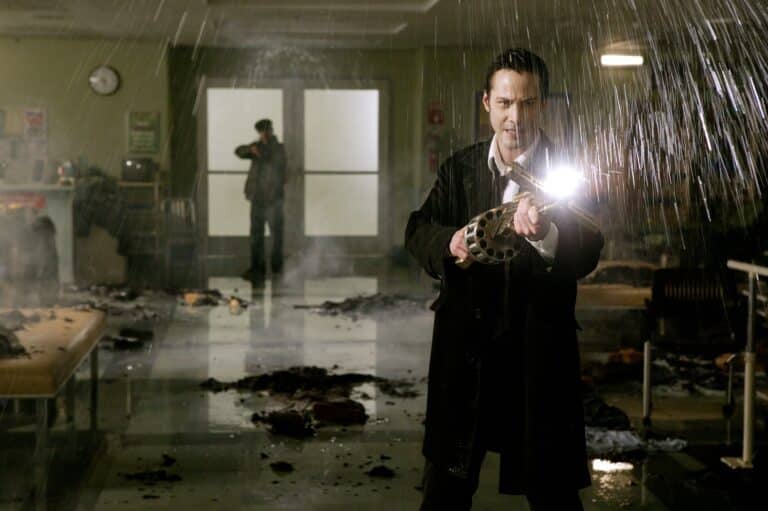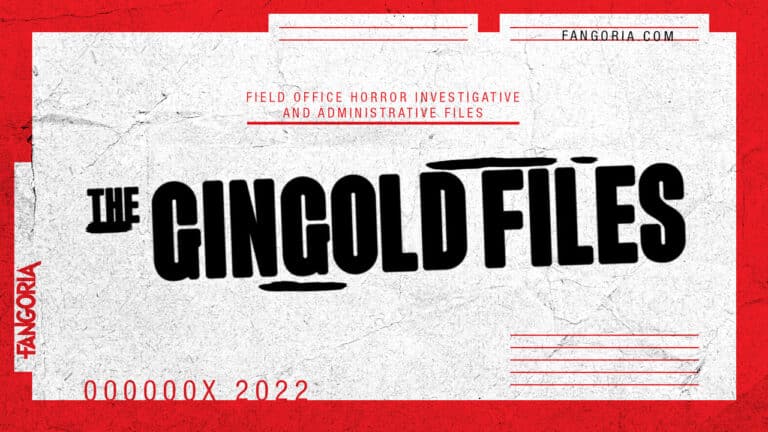
Last Updated on March 16, 2024 by Michael Gingold
Editor’s Note: This was originally published for FANGORIA on August 13, 2012, and we’re proud to share it as part of The Gingold Files.
“Now you’re going to ask me about the dog, right?” asks Guy Magar, director of 1987’s Retribution, at the close of our interview. I hadn’t planned to ask, though the rouged and dressed-up pooch that appears on a hotel desk in the movie (now out on a 25th-anniversary DVD) does warrant some attention.
“I was just going to put a dog on the counter in the hotel, and I was going to use my sister-in-law’s little poodle, who died three days before I was going to need it,” Magar recalls. “So I didn’t have a dog, and when I was shooting in the hotel there was this gentleman standing there, with the dog dressed just as it appears in the film: makeup and rouge and sunglasses, the whole deal. So I went up to him and asked, ‘Is this a performing dog or a circus dog?’ And he said, ‘No, it’s not,’ and he was very offended. I asked why the dog looked like this, and he said, ‘This is my wife.’ So I said, ‘Would you mind putting your wife on the counter for $35 a day?’ and he said, ‘No, you can have my wife.’ And that’s how I got the dog; it looks exactly like that in real life. Cost me $70.”
Ingenuity with limited money: it’s an approach that typifies Retribution, an unusually moody and stylish entry in the low-budget horror stakes. The story concerns a depressed artist named George (Dennis Lipscomb) who tries to commit suicide by jumping off his hotel’s roof. He appears to die, but then mysteriously returns to life, only to be compelled to visit people and places he’s never seen or known before. He also begins to have nightmares in which he sees himself using supernatural powers to kill more strangers, and then reads about the real-life deaths of the same people in the newspaper the next day. In concentrating on George’s character as he tries to unravel the mystery that his life has become, Retribution attains a depth not seen in most indie shockers, and this approach was very conscious on the part of Magar, who also co-wrote (with Lee Wasserman) and produced the film.
“Coming into the project,” he says, “I wanted to make sure that I didn’t wind up doing a B-slasher picture, the reason being that I don’t go see them and my friends don’t go see them. So the idea was not to do a Friday the 13th or a Nightmare on Elm Street or a Prom Night, as much money as those movies make. I wasn’t interested in that audience, and only that audience. I was interested in a much larger audience—people who go to movies like The Exorcist or The Omen or Poltergeist. The idea was to make a film that had great characters and a great story, and not just kill somebody every 10 minutes for no reason.”
Indeed, the scenes of graphic horror are spaced fairly evenly amidst lengthy dramatic stretches, and Magar says that he and Wasserman worked to assure a strong balance between the two. “This script was written very quickly, in seven days,” he recalls, “and [the story] kind of evened itself out as it went along. But during the rewrite stage, we were thinking very strongly about how to balance the characters and the story with the action. So we interchanged a number of scenes; there’s about a half hour more of the movie that we shot that is not in the picture anymore, because it unbalanced things. There was a lot more stuff that I was trying to do character-wise that I had to cut because the movie was getting longer and longer. Finally, when we got the movie down to 107 minutes, I felt that the balance between the horror and the characters was enough to please a crossover audience.”
The violence that does exist in the film, however, is extremely gory and shocking, so much so that the movie had to be cut to avoid an X rating (the unexpurgated grisly bits are included on the DVD as an extra). Magar, who began his career directing TV series such as The A-Team and Remington Steele, admits that this approach had partially to do with the comparative freedom that theatrical filmmaking allows in depicting violence. “There are a lot of things that are a little bit overdone in the picture, and I think that’s a natural thing that happens for a lot of first-time filmmakers—particularly those who are restricted, coming out of television,” Magar says. “They try to throw in the kitchen sink, they try to go for it. But it’s also part of my personality to try to do that. I believe that every scene, as a director, should be ‘maxed-out,’ whether it’s a love scene, or comedy, or a horror scene. I think it’s the responsibility of a filmmaker to deliver 100 percent of what the scene’s about. So there is a reaction from television, but also, I would probably go for it even if I didn’t have the television background. I would try to deliver everything I could.”
Retribution’s success also hinges on Lipscomb’s strong, involving performance in the lead role of George. According to Magar, the part was written specifically for the actor. “Dennis never read for the picture,” the filmmaker reveals. “I met Dennis on a TV show I did, and he was the most accomplished and exciting actor I’d ever met. So I wanted to work with him again, and Lee also knows him, so we wrote the script for Dennis, and there was never anybody else who was considered for the role. I wouldn’t have made the picture without him, because I knew his personality and all that, so the picture was designed for him right from the beginning. He was one of the most gifted actors I ever worked with in TV, so I wanted him to do my first feature.”
Magar adds that Lipscomb brought his own approach to the scenes in which George encounters his victims before killing them. “I was a little concerned about when he was ‘bad George’—when you first see him in the bar with his first victim, for example. It was his idea to keep George’s limp going, to keep the glasses on, to keep the cane. What he wanted was to do it more with his voice and his body posture. He felt that if we cheated completely, and lost the cane and the limp from the suicide attempt, and lost his glasses, that it was too much of a change, and didn’t need to be that much—and he was right. Dennis was very concerned about keeping some sort of continuity between when he’s ‘good George’ and when he’s ‘bad George.’ ”
Following Retribution, Magar was tapped to direct the sequels Stepfather III and Children of the Corn: Revelation, and continued in television as well on the likes of La Femme Nikita and Sliders. His only non-genre feature credit was 1994’s crime drama Lookin’ Italian, starring a pre-Friends Matt LeBlanc. “One of the problems with the film business is that they label you,” says Magar, whose memoir Kiss Me Quick Before I Shoot was published in 2011. “For example, in television, I was labeled an action-adventure director; that meant I couldn’t do comedy, I couldn’t do Afterschool Specials, I couldn’t do love stories. After my first show, Buck Rogers, some producers told me I was a sci-fi director and I couldn’t do anything else. I just love great filmmaking, and I would have loved the opportunity to make different kinds of movies as well as I could.”







